Dussehra
This celebration starts from Navratri and ends with the tenth day festival of “Dussehra”. Navratri and Dussehra is celebrated throughout the country at the same time, with varying rituals, but with great enthusiasm and energy as it marks the end of scorching summer and the start of winter season.
The tenth day after Navratri is called Dussehra, on which number of fairs are organized throughout the northern India, burning effigies of Ravana.It is also called “Vijayadashmi” as this day marks the victory of Lord Rama over Ravana. VijayaDashami is considered to be an auspicious day for the Indian householder, on which he worships, protects and preserves 'Shakti' (power). According to Scriptures, by worshipping the 'Shakti' on these nine-days the householders attain the threefold power i.e. physical, mental and spiritual, which helps him to progress in life without any difficulty.
The 'Ramlila' - an enactment of the life of Lord Rama, is held during the nine days preceding Dussehra. On the tenth day (Dussehra or Vijay Dasami), larger than life effigies of Ravana, his son and brother - Meghnadh and Kumbhakarna are set to fire.
The theatrical enactment of this dramatic encounter is held throughout the country in which every section of people participates enthusiastically.
In burning the effigies the people are asked to burn the evil within them, and thus follow the path of truth and goodness, bearing in mind the instance of Ravana, who despite all his might and majesty was destroyed for his evil ways.
Legends
Dussehra is also known as Vijaya Dasami, because of the victory of Ram over Ravana. On this day in Satya Yug, Ram (the eighth incarnation of Lord Vishnu), killed the great demon and king of Lanka, Ravana.
Puranas also opined that in this day warrior Goddess Durga defeated and killed the buffalo demon Mahishasura.
When is Dussehra?
Dussehra is the last day of Navratri; it falls on the 10th day of the waxing moon during the Hindu month of Ashvin (around September or October).
Dussehra in 2011 is on 6 th of October.
Legends
Victory of Rama over Ravana:
Rama was the eldest son of King Dasarath who was the ruler of Ayodhya. When Lord Rama was going to be crowned as the next King, Queen Kaikayee persuaded the king to crown Bharat as the next king and to send Rama on an exile for 14 years. On his exile Rama was accompanied by his brother Lakshman and wife Sita.
A demoness Soorpanakha got fascinated with the charm of Lord Rama and wanted to marry him, for which she threatened to kill Sita. Agitated with this, Lakshman cut her nose. Knowing about what happened to his sister; Demon Ravana wanted to take revenge and in turn abducted Sita. Lord Rama, along with Lakshman and Hanuman, fought a battle against Ravana and emerged victorious in rescuing his wife Sita.
Victory of Durga over Mahishasur:
The demon Mahishasur, was given a boon by the fir God (Agni), according to which, any weapon that had a masculine name couldn’t do anything to harm him. Taking the advantage of this boon, he caused immense destruction and hatred. The gods were very tensed and worried about this fact; they consulted Lord Vishnu over it, who advised them to invoke Goddess Shakti. With God’s prayers, a divine luster sprang from the heart of Lord Shiva and bodies of all gods forming the Adhya Shakti. The gods then gave her ornaments, and a lion as a vehicle. She was supposed to fight Mahishasur, the demon. For nine continuous days and nights, Goddess Adhya Shakti-Durga fought the demon-Mahishasur, and finally emerged victorious at the end.
Dussehra Celebration
The festival of Dussehra has great significance as it celebrated the triumph of good over evil. Although different places celebrate this festival in different manner, there is a common tradition of burning huge effigies of Ravana.
In Rajasthan, months before Dussehra, craftsmen engage themselves in making huge statues of Ravana, his brother Kumbhakaran and son Meghnath. They are beautifully crafted and decorated. On the main day of Dussehra, these effigies are burnt in large grounds (maidan), where huge crowd gathers to witness this traditional act of burning the evil. It is considered auspicious as along with the effigies, people burn their bad habits and bad deeds. It forms an atmosphere of purity and serenity. Kids buy small toys from these fairs as a memory of the day.
In Himachal Pradesh, a week long fair in the hill town of Kullu, is part of the Dussehra celebrations. From the little temples in the hills, deities are brought in procession to the 'maidan' in Kullu, to pay homage to the reigning deity, Raghunathji. The celebration actually begins nearly 10 days in advance as per tradition.
In Mysore, Karnataka the Mysore palace is illuminated for a whole month during Dussehra and caparisoned elephants lead a colourful procession through the gaily-decorated streets of the city. It is the most colourful celebration of Dussehra in world. The spectacular procession taken out on this day is really enjoyable.
In Tamil Nadu, the first three days are dedicated to the worship of Lakshmi, Goddess of wealth and prosperity, the next three days to Saraswati, Goddess of learning and arts and the last three days to Shakti (Durga).
In Tamil Nadu, Andhra Pradesh and Karnataka, families arrange dolls (Bommai Kolu) on artificially constructed steps and prepare an elaborate spread of lamps and flowers. Women traditionally exchange gifts of coconuts, clothes and sweets.
The whole set up is put on the very first day of Navaratri. Vijaya Dashamiy is an auspicious occasion for children to commence their education in classical dance and music, and to pay homage to their teachers.
In Punjab, Navaratri is taken as a period of fasting. In Gujarat, the evenings and nights are occasions for the fascinating Garba dance. The women dance around an earthen lamp while singing devotional songs accompanied by rhythmic clapping of hands.
Rituals
There are different rituals followed in different parts of India.
• Durga Puja:
Goddess Durga killed the demon Mahishasur during this time, representing the victory of good over evil. During all nine days of Navratri and Dussehra, people worship Goddess Durga.
• Durga Visarjan:
In the eastern parts of the country, particularly in West Bengal, Durga Puja celebrations precede Dussehra. On the tenth day of the Pooja, that is, the day of Vijayadashmi, idol of Goddess Durga is immersed into the nearby river or lake, by the devotees. The devotees bid the farewell to the deity very ceremoniously; this custom is called 'Visarjan'. In the region, Vijayadashmi is celebrated to commemorate the victory of Goddess Durga over Mahishasura the demon.
• Vidyarambam
In the Southern states of Tamil Nadu, Karnataka and Kerela,the tenth day or Vijayadashmi is also the day of Vidyarambam (beginning of study).People generally worship Goddess Saraswati,(Goddess of Wisdom), on Vijayadashmi. The day normally starts with puja of books and learning materials. It is considered very auspicious to start any form of learning on this day.
• Sindur Khela:
In the state of West Bengal, married women play among themselves with vermilion (sindur) as a part of Dussehra ritual.
• Weapon worship:
There is also a ritual of worshipping, weapons, pens, and other instruments that are a symbol of fighting injustice.
• Wagtail search:
In some parts of India there is a ritual of finding a wagtail on Dussehra day. If one is able to find a wagtail among flowers, elephants, cows, horses, snakes- it symbolizes good-luck. While if it is found in ashes, bones, then it is believed that an evil will follow, for which medicinal bath is taken
• Worship- instruments of Profession:
Across North India, this time is considered very auspicious to polish one’s professional instruments. Drivers, clean and polish their trucks and buses. They put Roli and draw swastika on them. This ritual is also performed in army and other forces.
• Banni leaves collection:
In parts of Uttar Pradesh ,this festival is associated with the ancient legend of the young Brahmin boy Kautsa's act of distributing gold coins among the poor people .Thus, people of Uttar Pradesh, collect leaves of Banni trees, calling them gold and using them to greet their friends and relatives. During this time people decorate the entrance of their houses with torans, and flower studded strings. The leaves of the Apta tree are collected and exchanged among friends and relatives as gold.
Dussehra Puja
Dusshera is celebrated on the 10th day of Shukla Paksh in the month of Ashwin. On this day, Shri Ram killed Ravan that is why it is called Vijaydashmi (victorious day). Traditionally the effigies of Ravan, his brother Kumbhkaran and son Meghnadh are filled with crackers and burnt.
On this day citing of Neelkanth, the bird is of great importance. She is supposed to be Shivji personified. Dusshera puja is performed by both men and women.
On this day a special image of Dusshera is drawn on the floor with wheat floor or chuna. People also worship a printed image of Dusshera.
Preparation for the Puja
* Image of Dussehra
* Cow dung, chuna
* Roli,moli, chawal, flowers
* Jhuwara which is grown on Navratre day
* Banana, mooli (radish), gwarphalli (flat cluster beans)
* Jaggery,1-1/4 kg chawal, money for offering, kheer, puri
* Bahikhata(account books)
Vidhi / Method of Performing Puja
* Draw the Dussehra image with wheat flour/chuna, put 9 tikki with cow dung.
* Make 2 katories of cow dung with a lid. In one katori, keep coins and in the other keep a little roli, chawal, fruit and jhuwara.
* Do puja with water, mooli, roli, chawal, flowers and jhuwara.
* Offer banana, mooli, gwarphalli, jaggery, 1-1/4 kg chawal.
* Light the dhoop and deepak, do the parikrama.
* Puia is done of the old bahikhata by offering flowers, jhuwara, roli and chawal.
* On this day only new bahikhata for Deepavali puja are ordered.
* After the puja, money from the cow dung box is taken out and placed in the safe.
* Food and dakshina are offered to the Brahmins.
Importance
The main importance and significance of the festival of Dussehra is the rise of “good over evil”. There are many legends behind the celebration of Dussehra, all depicting that ultimately it’s the “good” that wins.
• Among Hindus, Lord Rama is considered to have a culmination of all the best qualities that a human can possess, required to make this world a happy place. Both the festivals of Diwali and Dussehra are celebrated in honor of Lord Rama and his morals. Dussehra is the tenth day of Navratri, in the month of Ashwin-kartik, while Diwali is celebrated 20 days ahead of Dussehra. Lord Rama emerged victorious in a ferocious battle against Ravana who had abducted Sita. Inspite of all powers that Ravana possessed, it was ultimately the good intensions of Lord Rama that saw the face of Victory. This is generally depicted on the day of Dussehra by burning the effigies of Ravana and Lord Rama’s bow that kills him. People every year on this day get the moral of leading a righteous life.
• Dussehra also marks the day when Goddess Durga killed the demon Mahishasura. She had fought a long and ferocious battle against him, who had the boon of not getting harm with weapons. Ultimately, it was “the good” Goddess Durga who won on this day after a 10 day long battle.
Messages
A time for celebration, a time for victory of good over bad, a time when world see the example of power of good. Let us continue the same “true” spirit.
*
o This Dussehra, may you be blessed with good fortune
o As long as Ganeshji’s trunk
o Wealth and prosperity as big as his stomach
o Happiness as sweet as his ladoos
o And may your trouble be as small as his mouse
o Wish you and your family a fun filled Dussehra!
*
An auspicious day to start with any good work
It was today that good won victory over bad
May this day clear all hurdles of your life and start new era of well-being
Happy Dussehra!
*
Fortunate is the one
who has learned to admire,
But not to envy.
Good wishes for a joyous Vijayadashmi,
With a plenty of peace and prosperity
*
As the candlelight flame
Ur life may always be happy,
As the mountain high
U move without shy,
As sunshine creates morning glory
fragrance fills years as Flory,
All darkness is far away
As light is on its way.
*
As Shri Ram kills Ravana,
and comes back to people he loves,
As Ma Durga kills Mahishasura,
and prepares to go back to her heavenly abode,
May these good-over-evil stories,
Inspire you towards your own victories!
To meet great targets!
Aspire & Stretch!
Tide over bad-times!
Make the best of your good-times!
& just enjoy!
Wishing your and your family a Very Happy Vijayadashmi!
*
Everyday sun rise to give us a message
that darkness will always be beaten by light.
Let us follow the same natural rule
and enjoy the festival of the victory of good over the evil.
Happy Dussehra!
Dussehra 2011
Dussehra is a very popular and widely celebrated Hindu festival. It is believed that on this day, Lord Rama killed the demon king Ravana and rescued his wife Sita.Dussehra, also known as Vijaya Dashami is the tenth day of Navratri festival. Bengalis call this day as Durga Puja and Worship goddess Durga.
All over India huge fairs of Dussehra are organized, where effigies of Ravana are burnt and people get the moral of “Good always wins”.Dussehra is the last day of Navratri; it falls on the 10th day of the waxing moon during the Hindu month of Ashvin (around September or October).
Dussehra in year 2011 is on October 6th, Thursday.

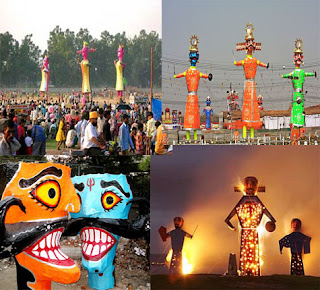

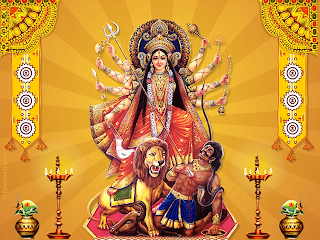
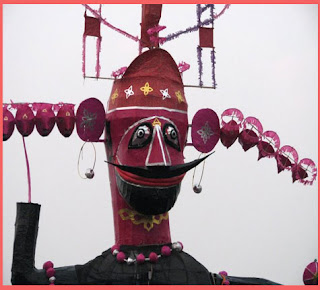
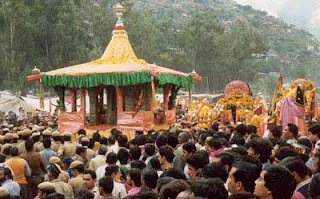
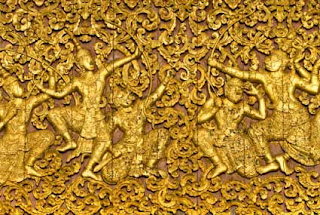
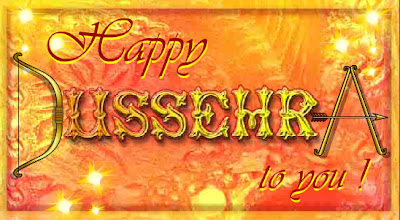





Post a Comment